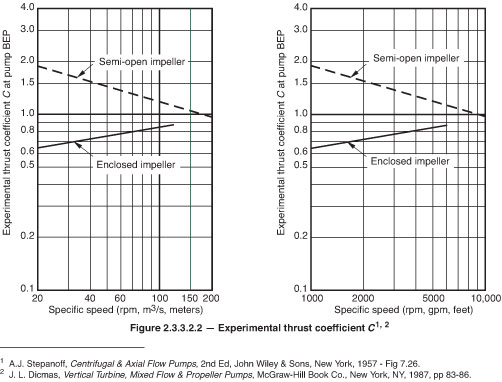Q. When selecting a motor for a vertical turbine pump, we need to know the down thrust from the pump so that the capability of the motor thrust bearing can be checked. How can the pump down thrust be calculated?
A. Below is a simplified version of this calculation, which was taken from a Hydraulic Institute Standard, ANSI/HI 2.3 Rotodynamic (Vertical) Pumps for Design and Application. This equation is for impellers with no back wearing ring and at BEP only.
US customary units:
Thrust at BEP in lb ![]()
Where:
H = Single stage head at BEP in ft
ρ = Density of pumped liquid in lb/ft3
g = Acceleration due to gravity in ft/s2
C = Coefficient from figure 2.3.3.2.2 below
Adf = Area of impeller front wearing ring minus shaft area in in.2
B = Number of bowls
W = Weight of all the impellers and total shaft in lb
Metric units:
Thrust at BEP in N = ![]()
Where:
H = Single stage head at BEP in m
ρ = Density of pumped liquid in kg/m3
g = Acceleration due to gravity in m/s2
C = Coefficient from figure 2.3.3.2.2 below
Adf = Area of impeller front wearing ring minus shaft area in mm2
B = Number of bowls
W = Weight of all the impellers and total shaft in N
Figure 2.3.3.2.2 provides the experimental coefficient “C,” which includes the impeller flow momentum change. This coefficient was obtained from a number of tests on vertical pumps with specific speeds from 1,700 to 12,000. The lines represent an average of these tests.
 |
| Figure 2.3.3.2.2 — Experimental thrust coefficient C1, 2 |
Q. Can you recommend internet resources that are useful in the selection of pump manufacturers and pump types?
A. The most obvious is the Hydraulic Institute. Go to www.pumps.org, and click “Find a Supplier” on the menu to the left. Open the drop-down menu titled “Product description,” and select the pump in which you are interested. Then click “Begin search,” and a list of suppliers of that pump will appear. Click on those that interest you to find a link to their website. You can also begin by selecting any other menus such as “Markets served” or “Location.”
There are many other useful websites that offer pump catalogs and allow you to select a pump based on type, manufacturer or application.
If you need more assistance about the pump selection process, numerous pump software programs are available online. A simple “pump software” online query will direct you to specialized software designed to guide the pump selection process.
Thomas Register is a classic, well-known product finder that is available online at www.thomasnet.com. Go to the search box, and type “pumps, etc.” and a list of suppliers will be offered.
Q. We are operating an end suction pump with a suction lift, and it sounds like it is pumping gravel, but the flow rate is as required. Is this noise due to cavitation, and if so, will it damage the pump?
A. To answer the question, we will need to know the value of net positive suction head available (NPSHA) and compare it to the NPSH required by the pump.
The equation for NPSHA in this installation is as follows:
NPSHA = hatm + hs + V2/2 g – hvp
Where hatm = atmospheric pressure in ft (m) of liquid pumped
hs = vacuum reading at the pump suction in ft (m) of liquid
V2/2 g = velocity head at the pump suction in ft (m) of liquid
hvp = vapor pressure of the liquid in ft (m)
To do this, a vacuum gage must be connected to the piping at the suction opening of the pump. After calculating the NPSHA, it can be compared to the NPSHR as determined by the pump rating curve.
If the NPSHA is greater than the NPSHR, the pump will produce at least 97 percent of the rated head but may not be cavitation free. To eliminate cavitation, NPSHA will have to be much greater than NPSHR. Experience has shown that the ratio of NPSHA to NPSHR must be from 2 to 5 to avoid cavitation.
It is likely that your pump is cavitating, but it may not be doing much damage. With a bronze impeller pumping water, the impeller life could be several years.

